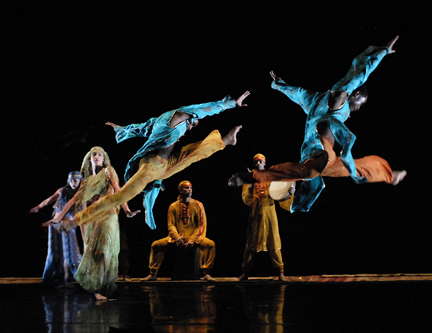Ballet Hispanico
“Corazón Al-Andaluz” and “Ritmo Y Ruido”
Ballet Hispanico
Joyce Theater
New York, NY
November 10, 2006
by Susan Reiter
copyright 2006 by Susan Reiter
 Ramón Oller clearly created “Corazón Al-Andaluz,” the major premiere of Ballet Hispanico’s season, with sober intentions and an interest in cross-cultural possibilities. His program note identifies the work's impetus and setting as a period in Andalusian history, from the eighth through the fourteenth centuries, when Muslim, Jewish and Christian cultures coexisted and enriched each other.
Ramón Oller clearly created “Corazón Al-Andaluz,” the major premiere of Ballet Hispanico’s season, with sober intentions and an interest in cross-cultural possibilities. His program note identifies the work's impetus and setting as a period in Andalusian history, from the eighth through the fourteenth centuries, when Muslim, Jewish and Christian cultures coexisted and enriched each other.
He has set the 45-minute work to a richly textured score that includes Sephardic melodies, guitar-accompanied Flamenco, more identifiably Arab music, and one blander, more familiarly Western song (sung in Spanish) near the end. (Individual musical selections are not identified in any detail beyond crediting the music to Rosa Zaragoza, Luis Delgado and Luis Paniagua.)
Three trios — two male, one female — swirl and stretch languidly around a central female, Candice Monet McCall, whose character is identified as Alma. Everyone is costumes by Willa Kim at her most sensual and gauzy — tunics and harem pants in shades of peach, gold and aqua, headscarves for the women and small caps for some of the men. Between the lush costuming and the music, there is a rich but vague sense of Atmosphere, but as the work meanders its way through its many sections, it is frustratingly low on substance and focus.
Oller gives these leggy, stretched-out dancers plenty of juicy but generic movement — spiraling turns, extravagant extensions — to flow and slink through. There were moments that looked like a sexed-up version of a yoga class. He identifies each trio in the program but leaves us to deduce what these identifications mean: the three darker-skinned men are grouped as “Corazón’s Men,” whole the three lighter-skinned ones are “Alhambra’s men.” Perhaps one needs a familiarity with Washington Irving’s “Tales of the Alhambra,” which inspired Oller (but is not mentioned in the program note).
 - Photo by Gene Schiavone.jpg) There is a lot of wary lurking, often on the small rugs that line the sides and rear of the stage, and the dancing evokes vaguely confrontational situations. The trios tended to move in unison, and their relationship to each other — beyond the differences suggested by the costuming — was never fully dramatized. One more intriguing section had “Alhambra’s Men,” now bare-chested, bringing on giant forks with ceremonial reverence, and then incorporating them into a section where they lifted and partnered Sara Koppraff, the work’s other solo female figure, identified as Judio. But the overall tone of the work was disappointingly glossy and superficial, and it began to feel like a Hollywood fantasy with simplistic exotic flavoring. The dancers did look quite beautiful and performed it with dignified dedication.
There is a lot of wary lurking, often on the small rugs that line the sides and rear of the stage, and the dancing evokes vaguely confrontational situations. The trios tended to move in unison, and their relationship to each other — beyond the differences suggested by the costuming — was never fully dramatized. One more intriguing section had “Alhambra’s Men,” now bare-chested, bringing on giant forks with ceremonial reverence, and then incorporating them into a section where they lifted and partnered Sara Koppraff, the work’s other solo female figure, identified as Judio. But the overall tone of the work was disappointingly glossy and superficial, and it began to feel like a Hollywood fantasy with simplistic exotic flavoring. The dancers did look quite beautiful and performed it with dignified dedication.
The flowing fabrics of Oller’s work gave way to the snappy, snug glossy black outfits of Ann Reinking’s 1997 “Ritmo Y Ruido,” in which the Broadway veteran dug further into on the Fosse-inspired choreography she created with such success of the revival of “Chicago” a year earlier, added a big of Latin-flavored zing and snap, and came up with a tight, crowd-pleasing work that has become a Ballet Hispanico staple.
Give the company points for providing contrast within this program; the two works could not have been more different. Reinking’s taut, witty 20 minutes wiped away the aimless prettiness that had preceded it, and, borne along effortlessly by the inventive, surprising percussion and vocal score created and performed (on tape) by Philip Hamilton and Tobias Ralph, the dancers dug into the tight formations and bursts of sharply articulated isolation with vigor and pizzazz. “Ritmo Y Ruido” is more about attitude than substance, but with its knowing sense of style and elegant pacing, it knows what it is about and what it wants to do. And — no small point — it makes the dancers look smart, sophisticated and sensational.
Photosm, both of 'Corazon Al-Andaluz," by Gene Schiavone.
Volume 4, No. 41
November 20, 2006
copyright ©2006 Susan Reiter
www.danceviewtimes.com